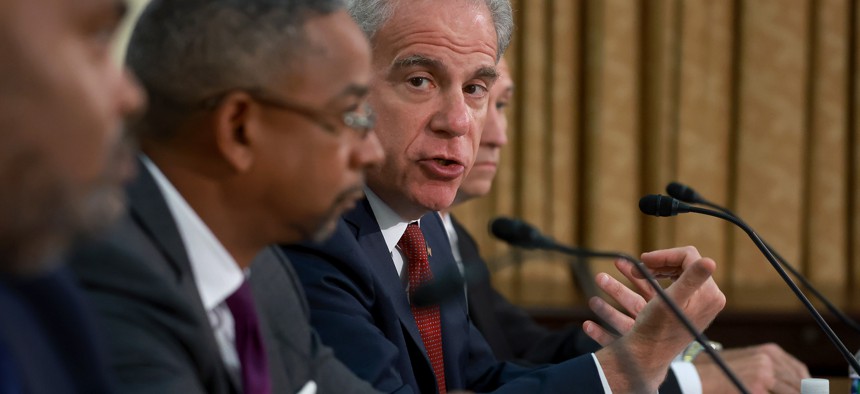How Cities and States are Gathering Data as They Spend Federal Aid

(L-R) Kevin Chambers, Director for COVID-19 Fraud Enforcement, Department of Justice; Hannibal "Mike" Ware, Inspector General, Small Business Administration; Michael Horowitz, Chair, Pandemic Response Accountability Committee; and Roy D. Dotson Jr., Acting Special Agent in Charge, National Pandemic Fraud Recovery Coordinator, United States Secret Service; testify during a hybrid hearing held by the House Select Subcommittee on the Coronavirus Crisis in the Rayburn House Office Building on June 14, 2022 in Washington, DC. Photo by Joe Raedle/Getty Images
A watchdog agency responsible for monitoring the historic infusion of pandemic relief dollars is promoting data collection to encourage transparency and uncover fraud and abuse.
The federal government is doling out billions in pandemic aid to state and local governments across the U.S. But how can Americans find out how all that money is being spent?
The Pandemic Response Accountability Committee, the watchdog agency responsible for monitoring the historic disbursement of federal dollars, promotes data collection both as a way to encourage transparency and uncover fraud, abuse and mismanagement. On Wednesday, the committee held a webinar featuring officials who have prioritized openness when it comes to pandemic relief funds.
“How we communicate data is essential,’’ said Julie Demuth, assistant director of budget and performance for Pierce County, Washington. “Communication is probably even more important than the data itself. You can put a ton of data out there and make it available to the public but if it’s not consumable or understandable, it really defeats the purpose.”
Like many communities, Pierce County has built a data tracker that allows the public to see where it has spent its $175 million American Rescue Plan Act allocation. The county’s ARPA projects include $5 million to acquire a hotel for those without housing and $1 million for services supporting the elderly.
Some of the local officials on the webinar shared challenges they faced when trying to make their data accessible to the public.
Lisa Martinez-Templeton, chief economist for the Denver Department of Finance, said some of the outside agencies it provided aid to were well versed in government reporting requirements. “But some agencies that we worked with were niche nonprofits that had nearly zero familiarity" with the government’s rules.
Data tracking has allowed jurisdictions across the nation to launch new initiatives and share ideas and best practices, Zachary Markovits, vice president and local practice lead at Results for America, a nonprofit policy group.
Forty percent of localities are infusing the federal funds into pilot new programs, Markovits said.
“Jurisdictions across the country are using these funds to grow their fundamental capacity to use data evidence … in the delivery of services,’’ he said. He cited Detroit, which is building a citywide data warehouse. The project’s initial focus will be on pandemic response.
The public availability of information regarding the spending of Covid aid has spurred communities to share ideas. Durham, North Carolina adopted an equity scoring matrix to apply to projects that was initially created by Pueblo, Colorado, Markovits said.
Jurisdictions are borrowing innovative ideas developed elsewhere and “replicating the parts that make sense for their community,” he added.
The Pandemic Response Accountability Committee was created by Congress in March 2020 to oversee several pandemic relief programs, including spending under the CARES Act and ARPA.
ARPA is funneling $350 billion in direct aid to states and localities all across the U.S. The CARES Act included $139 billion for states and larger-sized cities and counties, as well as $11 billion for Washington, D.C., territories and tribal governments.
The committee’s 21 inspectors general, who are charged with rooting out theft and abuse, recently asked Congress for more resources to prosecute fraud.
Daniela Altimari is a reporter for Route Fifty.
NEXT STORY: Biosurveillance network crucial to public health preparedness, GAO says





